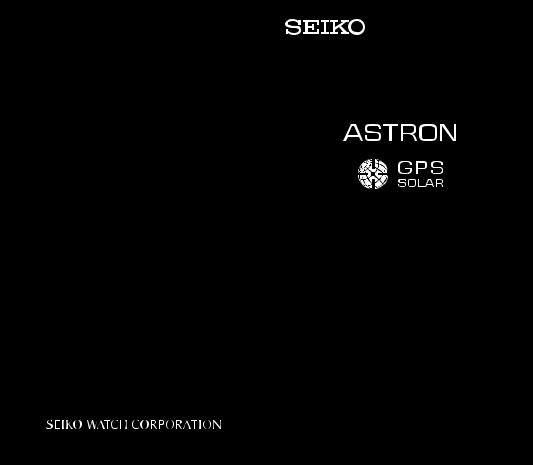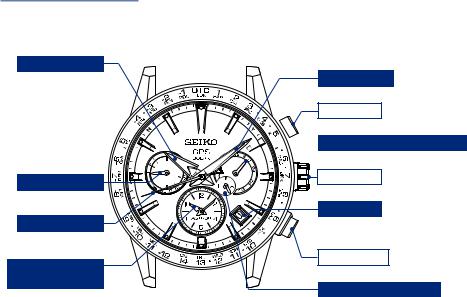Seiko Astron 5X53 User Manual

BSN5X53-A1811
5X53 HANDY MANUAL
< English >
Printed in Japan

Please carefully read the instructions in this Complete User Guide before using the watch.
For details, please read the “5X53 (GPS Solar) Complete User Guide”
(https://www.seikowatches.com/global-en/customerservice/instruction/).
Length adjustment service for metallic bands is available at the retailer from whom the watch was purchased. If you cannot have your watch repaired by the retailer from whom the watch was purchased
because you received the watch as a gift, or you moved to a distant place, please contact SEIKO WORLDWIDE SERVICE NETWORK.The service may also be available on a chargeable basis at other retailers, however, some retailers may not perform the service.
If your watch has a protective film for preventing scratches, make sure to peel it off before using the watch. If the watch is used with the film on it, dirt, sweat, dust, or moisture may be attached under the film and may cause corrosion.
1
CONTENTS
1. Features 3
2. Names of the parts 5
3. Check the charging status 7
4. Time zone 9
5. Time zone display and list of time zones around the world 11
6. Time zone adjustment (to adjust the time zone and time by GPS signal reception) 13
7. Manual time adjustment (to adjust only the time by GPS signal
reception) 15
8. Manual time zone selection (to set the watch to the local time of the
destination in an airplane, etc.) 17 9. DST setting of the main-dial 19
10. Manual time zone selection of the sub-dial 21
11. DST setting of the sub-dial 23
12. Switching between the main-dial
and sub-dial 25
13.When boarding (in-flight mode ( )) 27
)) 27
14.Leap second (Automatic leap second
reception function) 29 15. Reception result display 31
16. How to check when the time zone information was configured for your watch 33
2

1 Features
This is a GPS solar watch.
This watch has the following features.
GPS signal reception
This watch can be set to the precise local time by just one button operation anywhere in the world.
DST (Daylight SavingTime) is reflected in the time that appears.
This watch quickly adjusts the time by receiving GPS signals
from GPS satellites.
This watch responds to
a total of 39 time zones around the world. When the region or time
zone where the watch is used is changed, please
carry out operation of “time zone adjustment.”
Solar charging Function
This watch operates by solar charging.
Expose the dial to light to charge the watch. Once fully charged, the watch runs for approximately 6 months.
When the energy stored in the watch runs out completely, it takes time to fully charge the watch, so please keep in mind to charge the watch regularly.
Automatic time adjustment function
This watch automatically adjusts the time in accordance with action patterns during use.
When the watch has sensed sufficient brightness under an open sky, it automatically receives GPS signals from GPS satellites. This function enables the watch to automatically adjust the time precisely even while you are
using the watch.
This watch is unable to receive
GPS signals when the energy stored in the watch is low.
Unlike navigation equipment, this GPS solar watch is not designed to constantly receive GPS signals from GPS satellites without any operation. This watch receives GPS signals only in the time zone adjustment mode, automatic or manual time adjustment mode.
 Standard Charging Time
Standard Charging Time
GPS signal reception consumes a lot of energy. It is necessary to charge the watch by exposing it to light so that the indicator hand points to the “middle” or “full” position. (If the charging status is displayed as “low,” the reception will not start even with manual GPS signal reception.)
|
|
|
From the state where the watch is |
|
Illumination |
Light |
Condition |
stopped (not charged) |
|
lx (LUX) |
source |
(Example) |
To fully charged |
To one-second interval |
|
|
|
movement is secured |
|
|
|
|
|
|
700 |
Fluorescent light |
General offices |
|
|
3,000 |
Fluorescent light |
30W 20cm |
420 hours |
12 hours |
10,000 |
Fluorescent light Sunlight |
Cloudy day 30W 5 cm |
115 hours |
4 hours |
100,000 |
Sunlight |
Sunnyday(Underthedirectsunlightonasummerday) |
50 hours |
1.5 hours |
In the state where the hand moves (the watch is charged)
To move for one day
3.5 hours
1 hours
15 minutes
10 minutes
The figures of “Time required for charging the watch to start moving at one-second intervals” are estimations of time required to charge the stopped watch by exposing it to light until it moves at steady one-second intervals. Even if the watch is partially charged for a shorter period, the watch will resume one-second- interval movement. However, it may shortly return to two-second-interval movement. Use the charging time in this column as a rough guide for sufficient charging time.
3 The required charging time slightly varies depending on the design and the dial color of the watch. |
4 |

2 Names of the parts
Hour hand
Indicator hand
Second hand
Sub-dial (12-hour system)
Minute hand
Button A
 Day hand (day of the week)
Day hand (day of the week)
Crown
Date
Button B
Sub-dial AM/PM hand
Display of city name may vary depending on the model.
5 |
6 |

3 Check the charging status
The indicator hand position shows whether this watch is able or unable to receive GPS signals.
In addition, for the low charging state, the movement of the second hand shows the energy depletion state in further detail.
Reception is allowed
Indicator |
Charging |
Solution |
|
display |
status |
||
|
|||
|
full |
Reception is |
|
|
allowed. |
||
|
|
Reception is allowed, but middle keep in mind to charge the
watch.
Reception is not allowed
Indicator |
Movement of |
Charging status |
Solution |
|
display |
second hand |
|
|
|
|
1-second |
|
The watch |
|
|
|
is unable to |
Charge the watch at least until |
|
|
interval |
|
receive GPS |
the indicator hand points to the |
|
|
signals, but |
level position so that the watch is |
|
|
movement |
|
has energy |
able to receive GPS signals. |
|
|
|
to operate. |
|
|
2-second |
|
The watch |
|
|
low |
is unable to |
|
|
|
interval |
receive GPS |
Continue to charge the watch |
|
|
movement |
|
signals, and |
|
|
|
does not |
at least until the indicator hand |
|
|
|
|
have energy |
points to the level position |
|
|
|
to operate. |
so that the watch is able to |
|
5-second |
|
(The energy |
continuously operate and receive |
|
|
depletion |
GPS signals. |
|
|
interval |
|
forewarning |
|
|
movement |
|
function is |
|
|
|
activated. |
|
|
|
|
The charging status is |
Reset the in-flight mode ( ) as |
|
|
|
long as possible. |
||
|
|
not displayed for the |
When the indicator hand points |
|
|
|
in-flight mode |
||
|
|
to “low,” charge the watch |
||
|
|
( ). |
|
|
|
|
|
following the above. |
|
|
|
|
|
|
7 |
8 |

4 Time zone
 Time zone
Time zone
Based on Coordinated UniversalTime (UTC), the standard time commonly used is adopted by countries and regions around the world.The standard time is determined by each country or region, and the region where the same standard time is adopted is referred to as the time zone, and presently, the time zone is divided into 39 zones as of March 2018.
Further, DST (Daylight SavingTime) is individually adopted in countries and regions.
 DST (Daylight SavingTime)
DST (Daylight SavingTime)
Depending on the area, DST (Daylight SavingTime) is individually set.
Daylight SavingTime, or summer time, is a system to lengthen daylight time by advancing 1 hour when daylight time is longer during summer. Daylight saving time has been adopted in about 80 countries,
mainly in Europe and North America.The adoption and duration of daylight saving time varies depending on the country.
If the time zone adjustment is successful, data regarding the adoption of DST (Daylight SavingTime) for the country in which the GPS signals were received is reflected in the time that appears.
Daylight SavingTime is subject to change owing to circumstances of the country or region as of March 2018.
 Coordinated UniversalTime (UTC)
Coordinated UniversalTime (UTC)
UTC is the universal standard time coordinated through an international agreement. UTC is the primary time standard for recording time around the world. The time obtained by adding a leap second to the “International Atomic Time (TAI)” is determined based on the atomic clock around the world. It is coordinated in order to compensate for deviations from universal time (UT) which is astronomically determined by the UTC.
9 |
10 |
